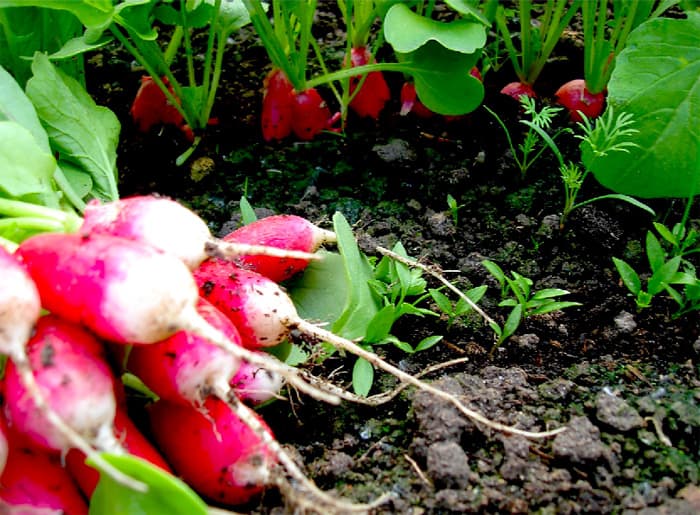The variety is ultra-early (ripening period is 18-20 days from emergence). The root crop is cylindrical, red with a white tip. The pulp is white, juicy, with a slightly spicy taste. It is used for growing in open and protected ground.
For sowing radishes, choose a site that comes out from under the snow early, with light, highly fertile soil.
Any vegetable crops, except for the cruciferous family, can be predecessors of radishes. Fertilizers are added to the soil before sowing.
Radishes are sown at several times: at the end of April (the bed is covered with film until shoots appear), then, if necessary, sowing is carried out at intervals of 2-2.5 weeks, for winter storage, late-ripening varieties are sown in early August. Seeds are sown in rows with 10-12 cm between rows, 2-3 cm between seeds, and a depth of 1-1.5 cm.
After the seedlings appear, it is necessary to regularly loosen the soil and keep it moist. In the middle of summer, when daylight hours are longest, it is recommended to shade the radish plantings. To obtain an earlier and later harvest, radishes are grown in protected soil (in spring, seeds are sown in early March, in autumn - in early September).

* How to grow radishes?
In fact, it is very simple: radish cultivation does not require any effort except watering.
In Estonia, radishes are sown in open ground from April 15 to May 15 and from August 15 to September 1. This is due to the fact that heat and long daylight hours are the cause of its bolting, although there are varieties that can be grown throughout the gardening season (as soon as the ground thaws and until it freezes again). For example, the "Duro" variety.
Soil preparation.
Radish loves loose, well-absorbing soil rich in fertilizers. For the first sowing, it is prepared in the fall and covered with film, and in the spring, before the snow melts, it is cleared.
As soon as the ground thaws about 20 cm - it is loosened and sowing is carried out. Add to the soil per 1 square meter: 1 bucket of manure humus, 1 bucket of rotted sawdust (if you don’t have it: 1 bucket of turf soil and 1/2 bucket of river sand), 1/2 liter of wood ash, 1/4 liter of garden lime (dolomite flour), 1 tablespoon of superphosphate, 1 tablespoon of nitroammophoska, 1 tablespoon of urea (carbamide) and 1 teaspoon of potassium fertilizers (potassium chloride or sulfate).
All this is evenly scattered over the dug area and dug up again, then leveled with a rake and a bed is formed (the bed should not be very high and not be sloping, so that water does not flow off it and stagnate, creating puddles). Sowing is carried out in transverse furrows 1 cm deep (for example, made with a rod).
The distance between the furrows is 5 cm, and between the seeds 2-3 cm, then the furrows are covered with the same soil, watered with warm water and covered with covering material (lutrasil, klimateks, agril and other similar agrotextiles).
Further care.
Usually, before the emergence of seedlings, the bed is covered with agrotextiles (in this case, watering the plants is not required). After the seeds have sprouted, watering is carried out after 1-2 days, and less often in cold weather.
When the ovary reaches the size of a large pea, watering should be done daily at the rate of 1-2 buckets per 1 m2. The more intensive the watering, the juicier the radish and the less bitter it is. The covering material does not need to be removed during the entire period of radish cultivation (however, to slow down growth during the fruiting stage, it is better to uncover it).












